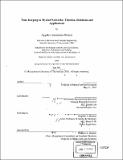| dc.contributor.advisor | Shrikumar Hariharasubrahmanian. | en_US |
| dc.contributor.author | Bletsas, Aggelos Anastasiou, 1975- | en_US |
| dc.contributor.other | Massachusetts Institute of Technology. Dept. of Architecture. Program in Media Arts and Sciences. | en_US |
| dc.date.accessioned | 2005-06-02T15:34:29Z | |
| dc.date.available | 2005-06-02T15:34:29Z | |
| dc.date.copyright | 2001 | en_US |
| dc.date.issued | 2001 | en_US |
| dc.identifier.uri | http://hdl.handle.net/1721.1/17522 | |
| dc.description | Thesis (S.M.)--Massachusetts Institute of Technology, School of Architecture and Planning, Program in Media Arts and Sciences, 2001. | en_US |
| dc.description | Includes bibliographical references (leaves 70-72). | en_US |
| dc.description.abstract | Distributed sensor networks make extensive use of a common time reference. In this work we address the problem of time dissemination in a packet switched network when the nodes are NOT generally all connected to an accurate, external time reference source. We thoroughly analyze Network Time Protocol - version 3 and identify its oversimplified clock modeling and its neglect of network delay variance (network jitter) as the primal causes for its inaccuracy. We explicitly address frequency skew in our clock model and propose a novel Kalman filtering technique for de-noising (remove of network jitter) during the NTP time synchronization process. The parameters of the Kalman linear estimator are optimal and they are computed online from the network environment, with a well-defined procedure. Our End-to-End technique decreases NTP rms error by two orders of magnitude and is compared with a software phased lock loop and a linear programming technique, with cross traffic exhibiting long-range dependence (fractional Brownian motion cross-traffic) or no dependence at all (white Gaussian case). We conclude with applications over packet switched networks that require time synchronization, like spatial filtering (beam-forming). The suite of algorithms and applications define a new class of packet switched networks, called Myriad Networks. | en_US |
| dc.description.statementofresponsibility | by Aggelos Anastasiou Bletsas. | en_US |
| dc.format.extent | 72 leaves | en_US |
| dc.format.extent | 2792762 bytes | |
| dc.format.extent | 2792570 bytes | |
| dc.format.mimetype | application/pdf | |
| dc.format.mimetype | application/pdf | |
| dc.language.iso | eng | en_US |
| dc.publisher | Massachusetts Institute of Technology | en_US |
| dc.rights | M.I.T. theses are protected by copyright. They may be viewed from this source for any purpose, but reproduction or distribution in any format is prohibited without written permission. See provided URL for inquiries about permission. | en_US |
| dc.rights.uri | http://dspace.mit.edu/handle/1721.1/7582 | |
| dc.subject | Architecture. Program in Media Arts and Sciences. | en_US |
| dc.title | Time keeping in myriad networks : theories, solutions and applications | en_US |
| dc.type | Thesis | en_US |
| dc.description.degree | S.M. | en_US |
| dc.contributor.department | Program in Media Arts and Sciences (Massachusetts Institute of Technology) | |
| dc.identifier.oclc | 49890366 | en_US |
